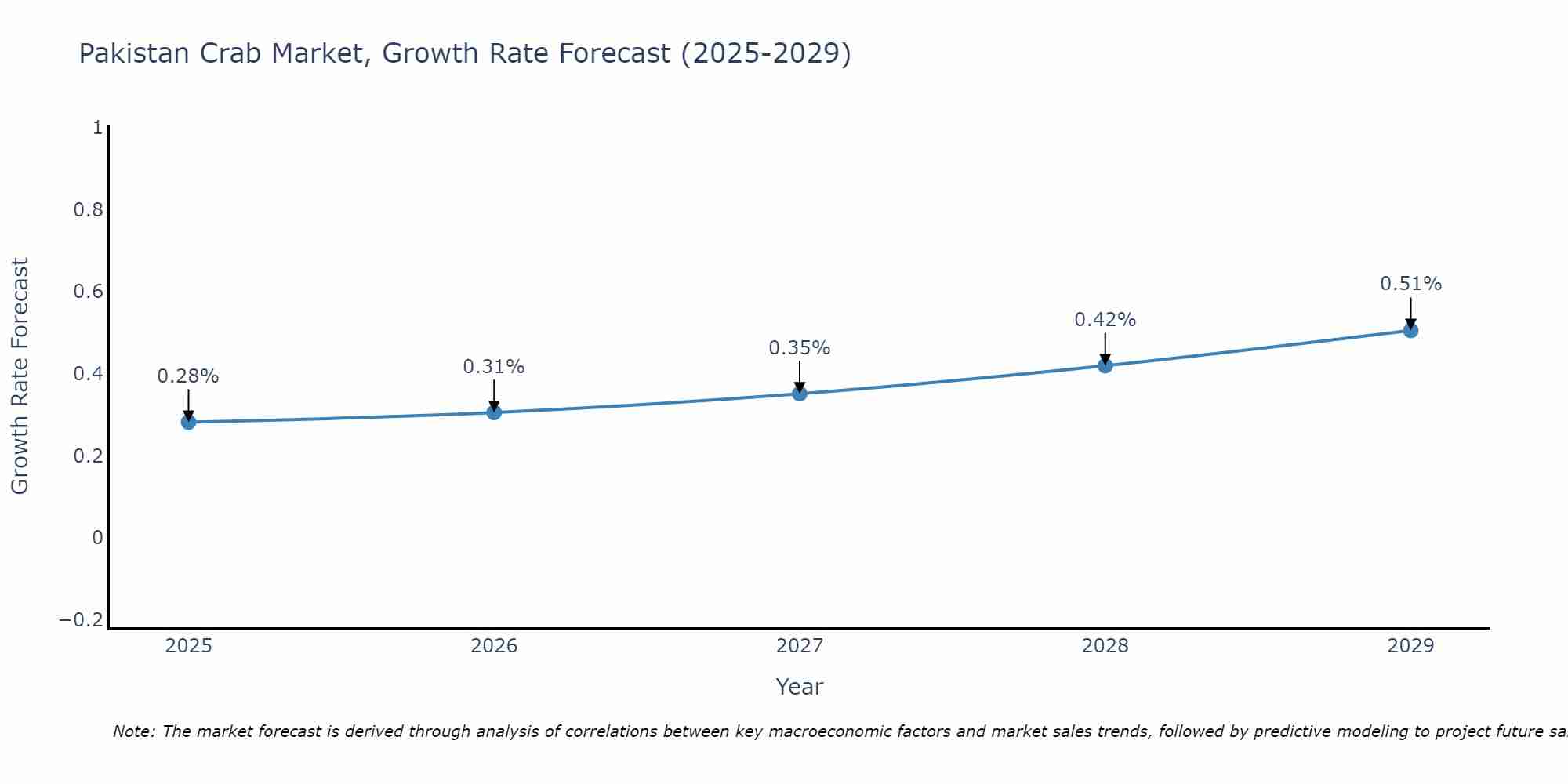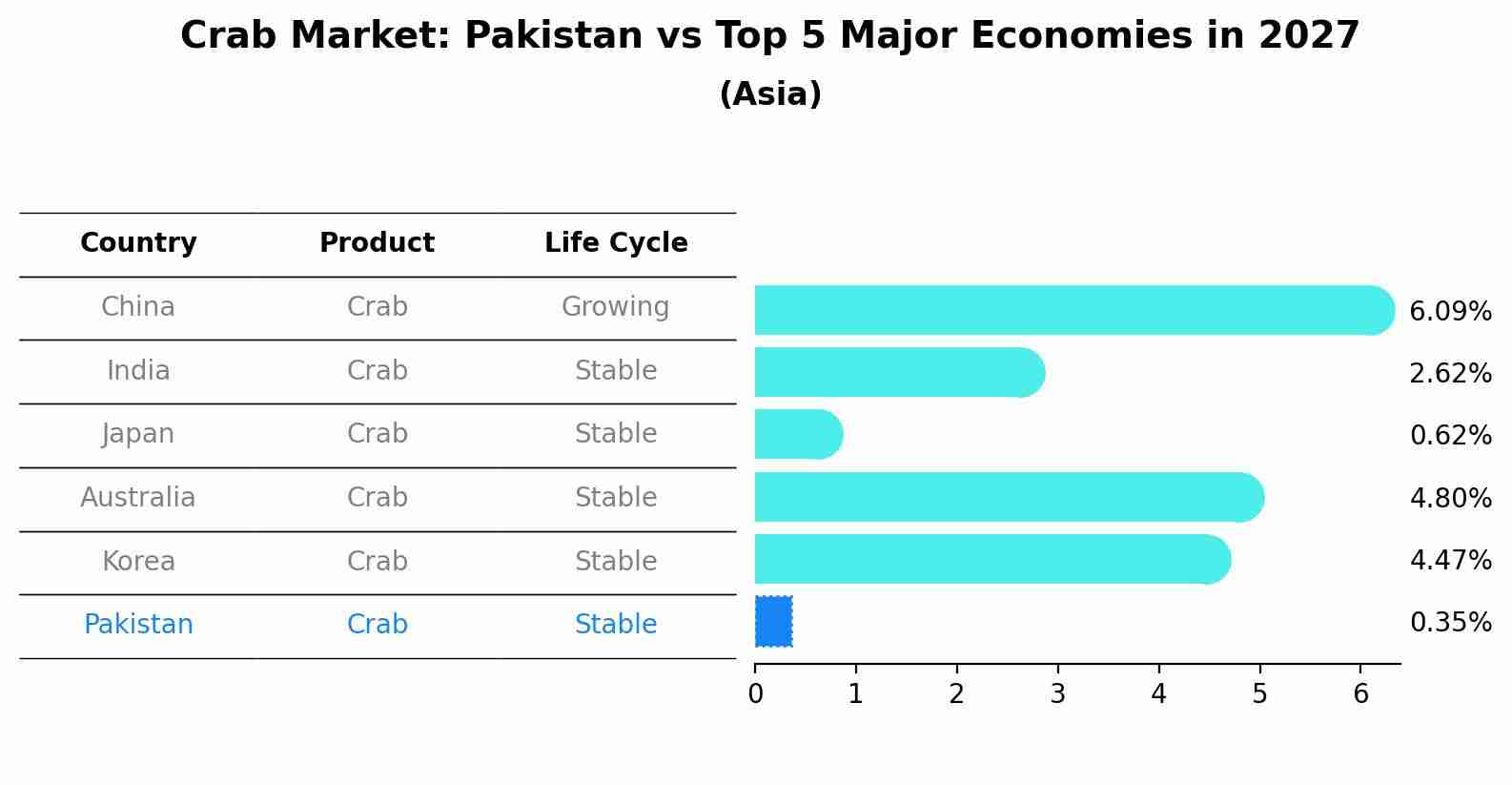Pakistan Crab Market Outlook | Analysis, Trends, Share, Revenue, Companies, Growth, Forecast, Industry, Value, Size & COVID-19 IMPACT
| Product Code: ETC088856 | Publication Date: Jun 2021 | Updated Date: Jun 2025 | Product Type: Report | |
| Publisher: 6Wresearch | Author: Dhaval Chaurasia | No. of Pages: 70 | No. of Figures: 35 | No. of Tables: 5 |
Pakistan Crab Market Size Growth Rate
The Pakistan Crab Market is poised for steady growth rate improvements from 2025 to 2029. The growth rate starts at 0.28% in 2025 and reaches 0.51% by 2029.

Crab Market: Pakistan vs Top 5 Major Economies in 2027 (Asia)
By 2027, Pakistan's Crab market is forecasted to achieve a stable growth rate of 0.35%, with China leading the Asia region, followed by India, Japan, Australia and South Korea.

Pakistan Crab Market Overview
The Pakistan crab market has been experiencing steady growth due to increasing consumer demand for seafood products. The market is primarily driven by the growing popularity of crab dishes in restaurants and hotels across the country. The coastal areas of Pakistan, such as Karachi and Gwadar, are known for their abundant crab populations, which serve as the primary sources for the market. Local fishermen play a crucial role in harvesting crabs, which are then supplied to markets and seafood vendors. The market is characterized by a mix of both domestic consumption and export opportunities, with countries like China, UAE, and Saudi Arabia being key export destinations for Pakistani crabs. The market faces challenges such as fluctuating prices, supply chain issues, and competition from imported crabs, but overall, it presents opportunities for growth and development in the seafood industry.
Pakistan Crab Market Trends
The Pakistan Crab Market is witnessing a growing demand for crab products, driven by increasing consumer interest in seafood delicacies. There is a noticeable shift towards sustainable and eco-friendly practices in crab fishing and farming, as consumers become more conscious of environmental impacts. The market is also seeing a rise in online sales channels for crab products, providing convenience to consumers and expanding market reach. Additionally, there is a trend towards premium and value-added crab products, such as ready-to-eat crab meat and innovative crab-based dishes, catering to diverse consumer preferences. Overall, the Pakistan Crab Market is evolving to meet changing consumer demands and preferences, with a focus on sustainability, convenience, and product innovation.
Pakistan Crab Market Challenges
In the Pakistan Crab Market, some of the key challenges faced include inconsistent supply due to overfishing and illegal fishing practices, strict regulations on crab fishing seasons leading to limited availability, lack of proper infrastructure for storage and transport resulting in quality deterioration, and competition from imported crabs affecting local prices and market share. Additionally, issues such as lack of awareness about sustainable fishing practices among local fishermen, fluctuating market demand, and the impact of environmental factors like pollution and climate change further contribute to the difficulties in the Pakistan Crab Market. Addressing these challenges would require improved regulatory enforcement, investments in infrastructure, education on sustainable fishing methods, and efforts to enhance market competitiveness and sustainability.
Pakistan Crab Market Investment Opportunities
Investment opportunities in the Pakistan Crab Market include the potential for growth in both domestic and international demand for crab products. The market is currently underserved, presenting opportunities for investors to enter and establish themselves as key players in the industry. With improvements in infrastructure and technology, there is room for expansion and efficiency in crab farming and processing operations. Additionally, the growing popularity of seafood consumption globally, particularly in markets like China and the Middle East, provides a lucrative export opportunity for Pakistani crab products. Investors can consider investing in crab farming operations, processing facilities, distribution networks, and exploring value-added product development to capitalize on the increasing demand for high-quality crab products in both local and international markets.
Pakistan Crab Market Government Policy
The Pakistan Crab Market is influenced by various government policies aimed at regulating the industry and ensuring sustainable practices. The government of Pakistan has implemented measures such as licensing requirements for crab fishing, setting catch limits to prevent overexploitation, and establishing marine protected areas to conserve crab habitats. Additionally, there are regulations in place to monitor and control the quality and safety of crab products to meet international standards for export. These policies aim to promote responsible fishing practices, support the livelihoods of local crab fishers, and safeguard the long-term health of crab populations in Pakistan`s waters. Compliance with these regulations is essential for the sustainable management of the Pakistan Crab Market and the protection of marine ecosystems.
Pakistan Crab Market Future Outlook
The future outlook for the Pakistan Crab Market appears promising due to increasing demand both domestically and internationally. Factors such as rising consumer interest in seafood, growth in the tourism industry, and improved infrastructure for transportation and export are expected to drive market expansion. Additionally, efforts to enhance crab farming practices and sustainability initiatives are likely to contribute to increased production and quality. With access to a variety of crab species and a reputation for flavorful and high-quality seafood, Pakistan is well-positioned to capitalize on the growing global market for crabs. However, challenges such as fluctuating market prices, environmental concerns, and competition from other seafood sources will need to be carefully managed to ensure sustained growth and profitability in the industry.
Key Highlights of the Report:
- Pakistan Crab Market Outlook
- Market Size of Pakistan Crab Market, 2021
- Forecast of Pakistan Crab Market, 2027
- Historical Data and Forecast of Pakistan Crab Revenues & Volume for the Period 2018 - 2027
- Pakistan Crab Market Trend Evolution
- Pakistan Crab Market Drivers and Challenges
- Pakistan Crab Price Trends
- Pakistan Crab Porter's Five Forces
- Pakistan Crab Industry Life Cycle
- Historical Data and Forecast of Pakistan Crab Market Revenues & Volume By Type for the Period 2018 - 2027
- Historical Data and Forecast of Pakistan Crab Market Revenues & Volume By Blue Crab for the Period 2018 - 2027
- Historical Data and Forecast of Pakistan Crab Market Revenues & Volume By Chinese Mitten Crab for the Period 2018 - 2027
- Historical Data and Forecast of Pakistan Crab Market Revenues & Volume By Gazami Crab for the Period 2018 - 2027
- Historical Data and Forecast of Pakistan Crab Market Revenues & Volume By Others for the Period 2018 - 2027
- Historical Data and Forecast of Pakistan Crab Market Revenues & Volume By Form for the Period 2018 - 2027
- Historical Data and Forecast of Pakistan Crab Market Revenues & Volume By Frozen for the Period 2018 - 2027
- Historical Data and Forecast of Pakistan Crab Market Revenues & Volume By Canned for the Period 2018 - 2027
- Historical Data and Forecast of Pakistan Crab Market Revenues & Volume By Others for the Period 2018 - 2027
- Pakistan Crab Import Export Trade Statistics
- Market Opportunity Assessment By Type
- Market Opportunity Assessment By Form
- Pakistan Crab Top Companies Market Share
- Pakistan Crab Competitive Benchmarking By Technical and Operational Parameters
- Pakistan Crab Company Profiles
- Pakistan Crab Key Strategic Recommendations
Frequently Asked Questions About the Market Study (FAQs):
1 Executive Summary |
2 Introduction |
2.1 Key Highlights of the Report |
2.2 Report Description |
2.3 Market Scope & Segmentation |
2.4 Research Methodology |
2.5 Assumptions |
3 Pakistan Crab Market Overview |
3.1 Pakistan Country Macro Economic Indicators |
3.2 Pakistan Crab Market Revenues & Volume, 2021 & 2027F |
3.3 Pakistan Crab Market - Industry Life Cycle |
3.4 Pakistan Crab Market - Porter's Five Forces |
3.5 Pakistan Crab Market Revenues & Volume Share, By Type, 2021 & 2027F |
3.6 Pakistan Crab Market Revenues & Volume Share, By Form, 2021 & 2027F |
4 Pakistan Crab Market Dynamics |
4.1 Impact Analysis |
4.2 Market Drivers |
4.3 Market Restraints |
5 Pakistan Crab Market Trends |
6 Pakistan Crab Market, By Types |
6.1 Pakistan Crab Market, By Type |
6.1.1 Overview and Analysis |
6.1.2 Pakistan Crab Market Revenues & Volume, By Type, 2018 - 2027F |
6.1.3 Pakistan Crab Market Revenues & Volume, By Blue Crab, 2018 - 2027F |
6.1.4 Pakistan Crab Market Revenues & Volume, By Chinese Mitten Crab, 2018 - 2027F |
6.1.5 Pakistan Crab Market Revenues & Volume, By Gazami Crab, 2018 - 2027F |
6.1.6 Pakistan Crab Market Revenues & Volume, By Others, 2018 - 2027F |
6.2 Pakistan Crab Market, By Form |
6.2.1 Overview and Analysis |
6.2.2 Pakistan Crab Market Revenues & Volume, By Frozen, 2018 - 2027F |
6.2.3 Pakistan Crab Market Revenues & Volume, By Canned, 2018 - 2027F |
6.2.4 Pakistan Crab Market Revenues & Volume, By Others, 2018 - 2027F |
7 Pakistan Crab Market Import-Export Trade Statistics |
7.1 Pakistan Crab Market Export to Major Countries |
7.2 Pakistan Crab Market Imports from Major Countries |
8 Pakistan Crab Market Key Performance Indicators |
9 Pakistan Crab Market - Opportunity Assessment |
9.1 Pakistan Crab Market Opportunity Assessment, By Type, 2021 & 2027F |
9.2 Pakistan Crab Market Opportunity Assessment, By Form, 2021 & 2027F |
10 Pakistan Crab Market - Competitive Landscape |
10.1 Pakistan Crab Market Revenue Share, By Companies, 2021 |
10.2 Pakistan Crab Market Competitive Benchmarking, By Operating and Technical Parameters |
11 Company Profiles |
12 Recommendations |
13 Disclaimer |
- Single User License$ 1,995
- Department License$ 2,400
- Site License$ 3,120
- Global License$ 3,795
Search
Thought Leadership and Analyst Meet
Our Clients
Related Reports
- Afghanistan Apparel Market (2026-2032) | Growth, Outlook, Industry, Segmentation, Forecast, Size, Companies, Trends, Value, Share, Analysis & Revenue
- Canada Oil and Gas Market (2026-2032) | Share, Segmentation, Value, Industry, Trends, Forecast, Analysis, Size & Revenue, Growth, Competitive Landscape, Outlook, Companies
- Germany Breakfast Food Market (2026-2032) | Industry, Share, Growth, Size, Companies, Value, Analysis, Revenue, Trends, Forecast & Outlook
- Australia Briquette Market (2025-2031) | Growth, Size, Revenue, Forecast, Analysis, Trends, Value, Share, Industry & Companies
- Vietnam System Integrator Market (2025-2031) | Size, Companies, Analysis, Industry, Value, Forecast, Growth, Trends, Revenue & Share
- ASEAN and Thailand Brain Health Supplements Market (2025-2031) | Strategy, Consumer Insights, Analysis, Investment Trends, Opportunities, Growth, Size, Share, Industry, Revenue, Segments, Value, Segmentation, Supply, Forecast, Restraints, Outlook, Competition, Drivers, Trends, Demand, Pricing Analysis, Competitive, Strategic Insights, Companies, Challenges
- ASEAN Bearings Market (2025-2031) | Strategy, Consumer Insights, Analysis, Investment Trends, Opportunities, Growth, Size, Share, Industry, Revenue, Segments, Value, Segmentation, Supply, Forecast, Restraints, Outlook, Competition, Drivers, Trends, Demand, Pricing Analysis, Competitive, Strategic Insights, Companies, Challenges
- Europe Flooring Market (2025-2031) | Outlook, Share, Industry, Trends, Forecast, Companies, Revenue, Size, Analysis, Growth & Value
- Saudi Arabia Manlift Market (2025-2031) | Outlook, Size, Growth, Trends, Companies, Industry, Revenue, Value, Share, Forecast & Analysis
- Uganda Excavator, Crane, and Wheel Loaders Market (2025-2031) | Strategy, Consumer Insights, Analysis, Investment Trends, Opportunities, Growth, Size, Share, Industry, Revenue, Segments, Value, Segmentation, Supply, Forecast, Restraints, Outlook, Competition, Drivers, Trends, Demand, Pricing Analysis, Competitive, Strategic Insights, Companies, Challenges
Industry Events and Analyst Meet
Whitepaper
- Middle East & Africa Commercial Security Market Click here to view more.
- Middle East & Africa Fire Safety Systems & Equipment Market Click here to view more.
- GCC Drone Market Click here to view more.
- Middle East Lighting Fixture Market Click here to view more.
- GCC Physical & Perimeter Security Market Click here to view more.
6WResearch In News
- Doha a strategic location for EV manufacturing hub: IPA Qatar
- Demand for luxury TVs surging in the GCC, says Samsung
- Empowering Growth: The Thriving Journey of Bangladesh’s Cable Industry
- Demand for luxury TVs surging in the GCC, says Samsung
- Video call with a traditional healer? Once unthinkable, it’s now common in South Africa
- Intelligent Buildings To Smooth GCC’s Path To Net Zero


















